

Review by: Andy Burgess
|
Harrap 1956 & reprint 1957 White Lion 1972 Corgi Paperback 1959 Sloane Associates 1957 reprint Ballantine 1978 paperback |

|
This book tells the story of the "Wheezers and Dodgers", DMWD of the British Royal Navy; the Department of Miscellaneous Weapons Development. Nevil Shute Norway spent most of the war working in this department, as a Lieutenant Commander, on the development of various weapons and devices for the Naval War effort. Shute had been working with his old Chief from the R100 project, Sir Dennistoun Burney, on the design of a gliding torpedo when Germany invaded the Low Countries. He decided that he should put down his slide-rule and go off and fight. At 40 he was too old to fly on operations, but the Navy were looking for "Elderly Yachtsmen", he wrote offering his services in the RNVR (Royal Naval Volunteer Reserve) and they accepted.
However he was not even to get into uniform before he was identified as having 'technical knowledge of aircraft', which was required by the Inspector of Anti-Aircraft Weapons and Devices (I.A.A.W.&D. for short). This was the 'cover' for the team that were to become DMWD lead by Commander Goodeve and Shute was to become one of his departmental heads. In his forward Shute describes himself as "furious" when he was called into this experimental department. Pawle writes that Shute was "in a state of almost apoplectic indignation" when he arrived, apparently "It was some time before Norway recovered his usual sangfroid.". Shute concludes his forward by describing his first impressions of Goodeve and the department and its usefulness as being very, very wrong in every particular.
The interest in this book to Shute 'fans' is that there are clear pointers to some of the themes and incidents depicted in his novels, particularly in Most Secret and Requiem for a Wren. Shute was involved with the use of flame throwers to try and deter dive bombers by projecting them vertically upward from ships. They proved to be a failure and later in the war Shute actually proved that they would also be of little use against troops in landing craft if mounted on a harbour breakwater. Perhaps he used them in the story precisely because he felt they would be of no use to a potential enemy?
DMWD were heavily involved in the preparations for D-Day and the problems of overcoming the beach defences. Shute would have been very familiar with the methods being used to gain information about the beaches and this is used in Requiem for a Wren where the narrator's brother is conducting such 'Commando' missions. Indeed many of the locations on the south coast of England used in Requiem are referred to in Secret War. The department was heavily involved in the use of landing craft of all types and the book describes particularly the development of the rocket firing landing craft called the Grasshopper. Shute uses this detail very effectively in Requiem describing the build up to D-Day. The eponymous Wren of the story is an ordnance wren and DMWD also were involved in the adoption of the Oerlikon anti-aircraft gun.
Whilst reading the Secret War you continuously come across items that can be identified in Shutes' works. It gives fascinating insights into Shute's activities in the period that comes immediately after that covered by his autobiography Slide Rule. However, the book is an enjoyable 'read' in itself with extraordinary stories of the staff of DMWD, many associated with (literally) explosive situations. The famous use of the pier at Weston-Super-Mare is described and one gets a vivid picture of Shute and his colleagues travelling here and there around the country developing these extraordinary devices. One of Shute's less successful ventures, the great Panjandrum, is highlighted. Here his literary side contributed to the technical, he named it so "because the gunpowder ran out from its heels", from the piece of nonsense composed by the actor and dramatist Samual Foote to test the actor Charles Macklin's claim that he could memorize anything.
Many of the gadgets devised by Shute and his colleagues were either straight failures or developed too late for the particular use intended, but many others were critical to success in the war. The characters involved were quint essentially English eccentrics. Little military discipline or etiquette was present in DMWD, but the dedication and innovation of these men comes through clearly. They would all have been very much at home in a Shute novel, and indeed perhaps they are!
This book is, of course, out of print, but a search on abebooks.com provided a substantial list of copies of the various editions. I obtained a copy easily through my local library as here in Bristol this is regarded as local history due to the involvement of Weston-Super-mare. It should be possible, in the UK at least, to obtain paperback copies at quite low prices, indeed if ordering from overseas the postage may exceed the cost of the book! I would recommend the book to anyone interested in Shute's life and particularly if you are also interested in the war and the more 'scientific' side of it.
Andy Burgess